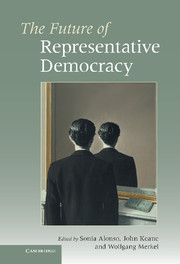Book contents
- Frontmatter
- Contents
- List of figures
- List of tables
- Notes on contributors
- Acknowledgements
- Editors' introduction: Rethinking the future of representative democracy
- 1 Representative democracy and its critics
- 2 Representative democracy and the populist temptation
- 3 The wider canvas: representation and democracy in state and society
- 4 Performance and deficits of present-day representation
- 5 Do parliaments have a future?
- 6 Engendering representative democracy
- 7 Representative democracy and the multinational demos
- 8 Diagnosing and designing democracy in Europe
- 9 Monitory democracy?
- 10 Representing nature
- 11 Democracy and representation beyond the nation state
- General bibliography
- Index
Editors' introduction: Rethinking the future of representative democracy
Published online by Cambridge University Press: 05 June 2012
- Frontmatter
- Contents
- List of figures
- List of tables
- Notes on contributors
- Acknowledgements
- Editors' introduction: Rethinking the future of representative democracy
- 1 Representative democracy and its critics
- 2 Representative democracy and the populist temptation
- 3 The wider canvas: representation and democracy in state and society
- 4 Performance and deficits of present-day representation
- 5 Do parliaments have a future?
- 6 Engendering representative democracy
- 7 Representative democracy and the multinational demos
- 8 Diagnosing and designing democracy in Europe
- 9 Monitory democracy?
- 10 Representing nature
- 11 Democracy and representation beyond the nation state
- General bibliography
- Index
Summary
The fusion of representation and democracy
The invention of representative democracy is often said to be among the distinctive achievements of modern politics. It came as no easy victory. In its European homeland, it took seven centuries (and quite a few rebellions and revolutionary upheavals) to consolidate representative institutions. Church hierarchies had to be resisted in the name of true religion. Monarchs had to be brought under the control of assemblies. Legislatures then had to be subjected to democratic election, and in turn these democratic elements had to be grafted onto pre-democratic institutions of representation. The model of representative democracy that resulted is today familiar – within the European region, the United States, Chile, Japan, India and other countries – as a cluster of territorially bound governing institutions that include written constitutions, independent judiciaries and laws. These institutions guarantee such procedures as periodic election of candidates to legislatures, limited-term holding of political offices, voting by secret ballot, competitive political parties, the right to assemble in public and liberty of the press.
Compared with the previous assembly-based forms of democracy associated with the classical Greek world, representative democracy was different. The ancient world knew nothing of representation; it did not even have a word for it. The citizens of Athens, for instance, thought of their democracy as direct and participatory.
Information
- Type
- Chapter
- Information
- The Future of Representative Democracy , pp. 1 - 22Publisher: Cambridge University PressPrint publication year: 2011
Accessibility standard: Unknown
- 7
- Cited by
